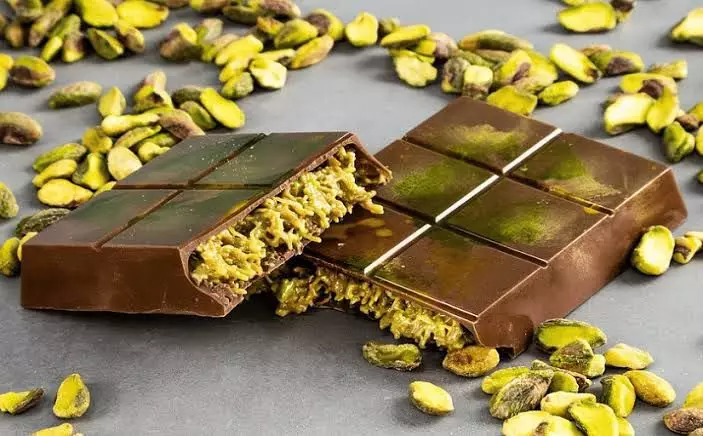₹800 to ₹1,350: Prices of pistachio skyrocket in Hyderabad, thanks to TikToker’s Dubai chocolate bite
Pistachio isn’t just a dry fruit anymore—it’s a vibe
By Anoushka Caroline Williams
Hyderabad: Once upon a time, pistachios were a festive delight in India. Brought out during Diwali and tucked into biryanis, or sprinkled on creamy kulfis. Today, thanks to a viral chocolate from Dubai and the power of social media, this once-humble nut has become the unlikely symbol of a new kind of inflation: one driven not by drought or geopolitics—but by dessert videos.
A Chocolate from Dubai, A Crisis in Dry Fruits?
It started innocently enough. A TikTok influencer posted a dramatic slow-mo of herself biting into a pistachio-stuffed chocolate bar drizzled with gold. Within weeks, Indians from Hyderabad to Delhi were searching for “Dubai chocolate” knock-offs.
Bakers all over were flooded with custom requests. Pistachio prices began to rise—not just in international markets, but at your friendly neighbourhood dry fruit shop.
“I used to buy pistachios for ₹800/kg just a year ago. Last week, I paid ₹1,350,” says Deepti Mehta, speaking to Newsmeter, a home baker in Hyderabad who makes premium pistachio cakes. “It’s now more expensive than almonds and almost as steep as cashews, which used to be the ‘fancy’ one.”
When Social Media Controls the Market
We’ve seen this story before—remember the avocado toast era? What began as a hipster breakfast item in Brooklyn ended up affecting demand and prices in Mexico, New Zealand, and even parts of Karnataka. Now, pistachios are having their viral moment, and the shockwaves are being felt from Iranian farms to Indian kitchens.
“People don’t realise the reach of social media today,” says Amit Narang, a food trend analyst. “When a food trend goes viral globally, even local markets aren’t immune. A 30-second video can shift demand curves faster than any traditional ad campaign.”
Supply Can’t Keep Up
Globally, pistachios are facing a tough harvest year, especially in California, one of the world’s largest producers. Meanwhile, countries like Iran and Turkey are trying to scale exports to meet demand. But the sudden spike in interest from non-traditional markets, like India’s urban Gen Z and affluent millennials, is adding unexpected pressure.
“There’s an increased demand from bakeries, home chefs, and gifting companies, especially for premium green pistachio,” says Abdu Jaffer, owner of a dry fruit store in Hyderabad’s Begum Bazaar. “Earlier, people bought pistachios in grams. Now they want kilos, and they want it fast.”
Pistachio: The New Status Symbol?
What’s fascinating is how a single ingredient has been rebranded into a symbol of indulgence. Pistachio isn’t just a dry fruit anymore—it’s a vibe. Instagram reels now feature pistachio cream being drizzled on toast, stuffed into croissants, and stirred into iced coffee. Brands are capitalising fast: from gourmet ice cream parlours to new-age mithai shops.
“We just launched a pista-peda inspired by the Dubai chocolate,” says Shruti Agarwal, co-founder of a modern Indian sweets brand. “It’s our best-seller—people associate it with luxury.”
The Road Ahead: Sustainable Trend or Passing Fad?
While demand is booming, some experts warn this could be a short-lived sugar rush. “Food trends are cyclical,” says Dr. Diya Iyengar, an agricultural economist. “But what’s worrying is the supply-side stress it creates. If farmers start shifting to high-profit crops like pistachios too fast, we might disrupt other staples.”
And yet, for many Indian consumers, the pistachio wave has only just begun. Be it in thandai, modaks, or high-end chocolates, the nut has found a new calling.
In a nutshell—pun intended—pistachios have gone from a dusty dry fruit box to the centre of a global trend. And in India, where food is culture, celebration, and competition all at once, even a foreign chocolate can shake up local markets.
Now, if only someone could make it viral to eat more chana dal—maybe we’d finally see inflation work in our favour.